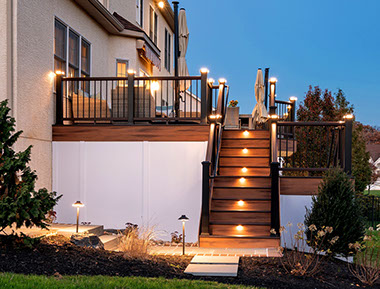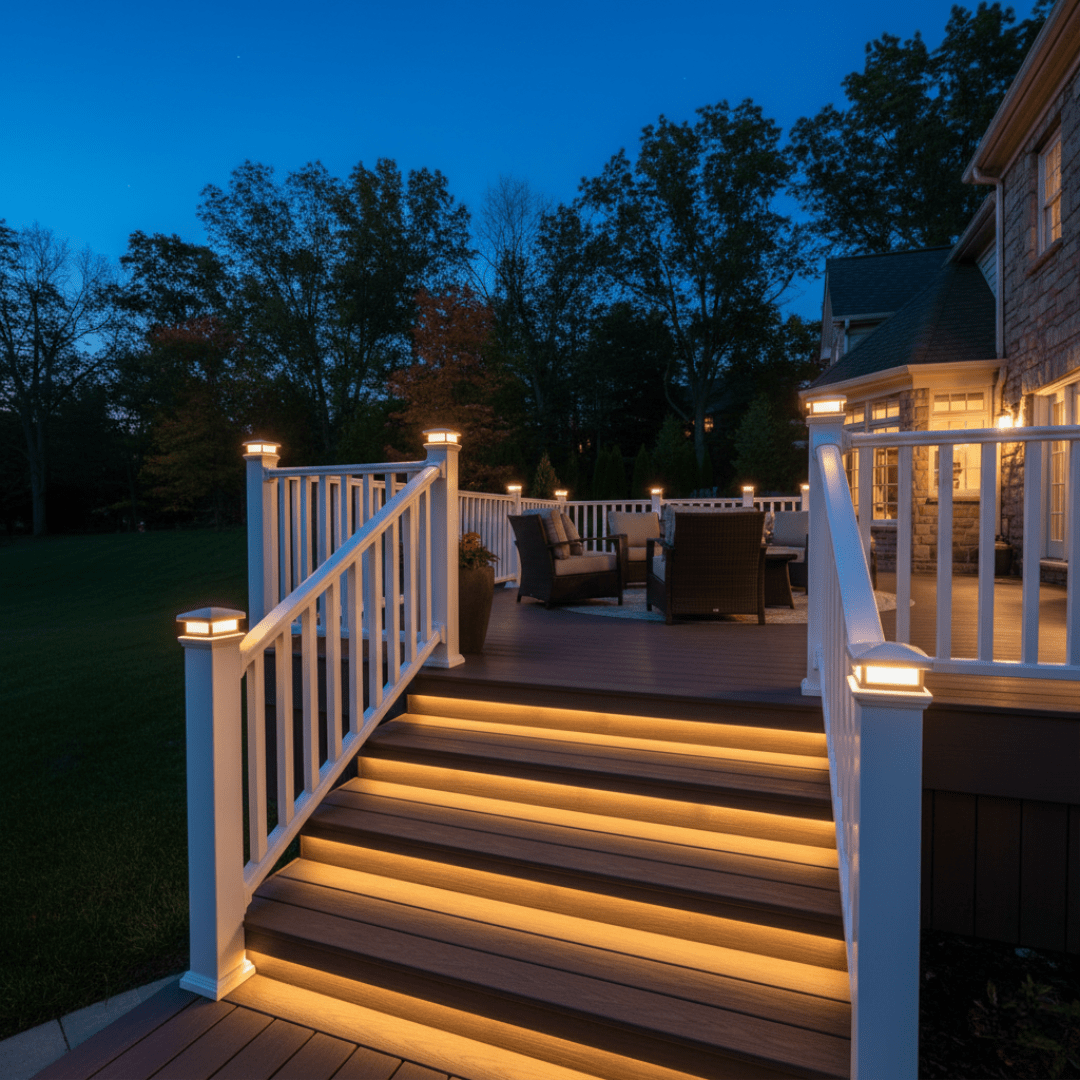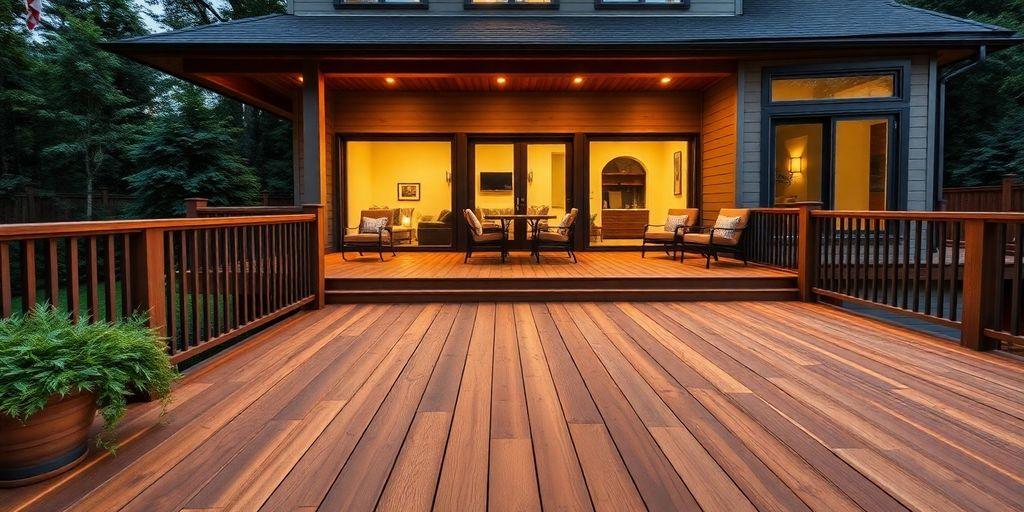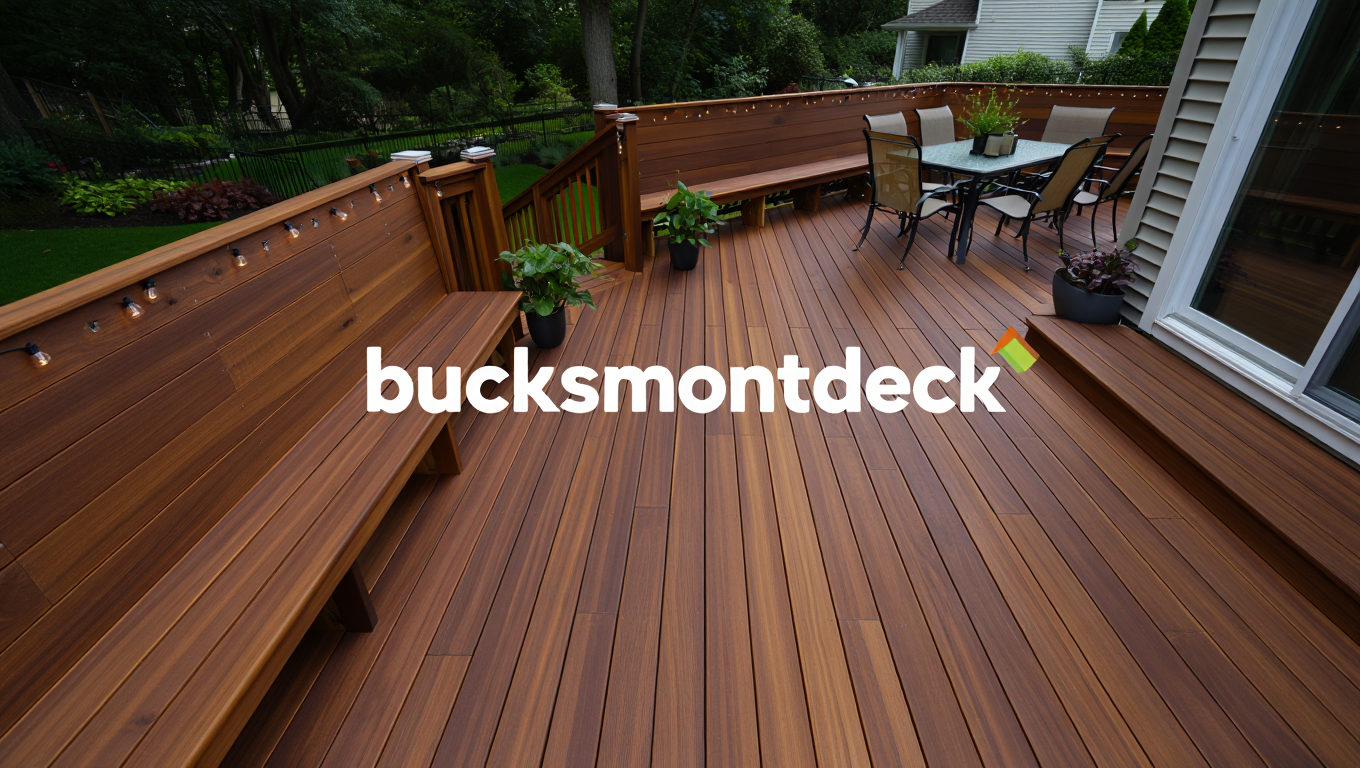Introduction
Have you ever dreamed of stepping outside your home and being greeted by a stylish, functional deck where you can savor your morning coffee, host weekend barbecues, or simply lounge under the stars? Backyard deck designs are becoming increasingly popular for homeowners who want to expand their living spaces. In Pennsylvania, in particular, where seasonal changes bring both vibrant summers and crisp winters, having a versatile outdoor area can be a real asset.
In this post, we’ll walk through five standout designs that cater to modern tastes and practical needs. Each layout offers its own set of advantages, from multi-level masterpieces to floating platforms, rooftop escapes, covered retreats, and seamless indoor-outdoor blends. These deck building ideas (check out our deck design services) aim to spark your imagination and guide you toward a new centerpiece for your backyard.

1. Multi-Level Marvel
Why Choose a Multi-Level Deck
If your backyard has varying elevations—or if you simply want distinct spaces for different activities—a multi-level deck is a top contender among outdoor deck designs. Picture this: a designated grilling station on the lower level, a spacious dining area on the main platform, and a cozy fire pit lounge up top. By dividing your deck into multiple tiers, you create specialized zones without sacrificing a cohesive look.
Beyond aesthetics, multi-level decks offer practical benefits. You can set up child-friendly play areas away from the cooking space, or carve out a private nook for reading and relaxation. It’s like having several rooms, only outdoors!
Material Selection and Maintenance
Before diving in, consider which materials suit your lifestyle and local climate. In Pennsylvania, humidity and fluctuating temperatures can impact the longevity of your deck. Common choices include:
- Composite boards: Known for their durability, low maintenance, and resistance to rot.
- Cedar or redwood: Natural beauty with built-in rot resistance, though they do require sealing and staining to maintain their look.
- Pressure-treated lumber: Cost-effective and widely available, but may need more frequent upkeep.
The time you invest in maintenance can help you get the most out of your multi-level design. A regular schedule of cleaning, sealing, or staining helps prevent water damage and fading.
Pros and Cons at a Glance
Pros | Cons |
Separates functional areas (e.g., dining, lounging) | Potentially higher construction costs due to complexity |
Adds visual intrigue and depth | May require a professional designer or architect |
Maximizes use of sloped or uneven terrain | Longer build time, depending on the number of levels |
Pro Tip
If you’re thinking of selling your home down the line, a well-constructed multi-level deck can increase property value and curb appeal. It’s an investment that often pays off when it’s time to put your house on the market. For more industry guidelines, consult the North American Deck and Railing Association (NADRA).

2. Floating Deck Oasis
Defining a Floating Deck
When people talk about backyard deck designs that are easy to install and adapt, floating decks come up a lot. A floating deck, or freestanding deck, isn’t attached to your home’s structure, making it more flexible in terms of placement. Whether you want to set up a cozy reading nook under a shade tree or place your deck near a garden, a floating design gives you plenty of freedom.
Ideal for Limited Space
Floating decks can be tailored to both large and small backyards. For those with limited space in crowded neighborhoods—or even in more spacious Pennsylvania suburbs—this style offers a compact solution without skimping on style. You can decorate with potted plants, cozy chairs, or even a small bistro table to capture that “outdoor cafe” vibe.
Tips for Easy Installation
- Level the ground: Ensure the soil is compact and level. You may need gravel or pavers for additional support.
- Check local regulations: Although some floating decks are permit-free, rules vary by municipality. (See expert guidance for more details.)
- Stabilize: Use concrete blocks or deck foot anchors for foundational security.
Maintenance
Floating decks are generally low-maintenance, but you’ll want to keep an eye on:
- Shifting soil: Pennsylvania’s freeze-thaw cycle can cause ground movement.
- Moisture: Clear away debris to prevent mold or mildew.
Overall, a floating deck is one of the more approachable deck building ideas, especially if you’re handy with DIY projects.

3. Rooftop Retreat
The Ultimate Urban Deck
If your home has a flat or gently sloping roof, transforming that space into a rooftop retreat can be the ultimate statement in modern outdoor living. It’s a way to maximize your home’s footprint—especially in urban areas where yard space might be limited.
Imagine hosting sunset gatherings with panoramic views, or cultivating a small container garden right above your living quarters. Rooftop decks can quickly become the star of any property, combining luxury with practicality.
Waterproofing and Structural Considerations
Rooftop decks are no joke when it comes to planning and construction. Waterproofing is paramount to protect your home from leaks. You’ll also need a thorough structural assessment to confirm your roof can handle the additional load—especially if you plan to add heavy items like hot tubs or large planters. Working with a professional engineer or experienced contractor is highly recommended. You can also review up-to-date building standards from the International Code Council (ICC).
Design Elements
- Pergolas or shade sails: Offer relief from direct sunlight and add a dramatic flair.
- Built-in seating: Maximize space and streamline the deck’s appearance.
- Glass railings: Enhance safety without obscuring those awesome views.
When executed well, a rooftop deck not only provides an additional living area but also elevates the overall look of your home.
4. Covered Deck Haven
Weather-Ready Living
Pennsylvania’s climate ranges from sunny and humid summers to brisk winters, making a covered deck a wise investment. By incorporating a roof or pergola, you create a functional space that can be enjoyed almost year-round. A covering also shields your deck’s surface from harsh sunlight and moisture, extending its lifespan.
Material and Style Options
Covered decks don’t have to look uniform. Depending on your home’s architecture and your personal taste, you can choose from a variety of styles:
- Gabled Roof: Matches traditional home designs; allows for good air circulation.
- Flat Roof: Clean, modern aesthetic; simpler construction.
- Pergola: Offers partial shade while letting some sunlight filter through.
- Retractable Awnings: Flexibility at your fingertips—use it when you need shade, retract it when you want full sun.
For the deck surface, composite or pressure-treated wood is a popular choice due to durability. Remember, a well-sealed, covered deck can stand up to Pennsylvania’s rain, snow, and sun without constant upkeep.
Comfort-Boosting Extras
- Ceiling Fans: Keep air circulating during humid summers.
- Lighting: String lights or recessed fixtures for ambiance.
- Outdoor Heaters: Extend usage into colder months.
- Screens or Curtains: Increase privacy and protection from insects.
A covered deck quickly becomes an outdoor living room, perfect for everything from weekday breakfasts to weekend parties.
5. Seamless Indoor-Outdoor Blend
Blurring Boundaries
One of the most sophisticated outdoor deck designs you can opt for is the seamless indoor-outdoor blend. This concept often involves large sliding or folding glass doors that unify your interior living space with the deck. When the doors are open, you’re treated to a continuous flow of fresh air and natural light, making your home feel significantly larger.
Color and Material Coordination
To nail this design, consistency is key:
- Flooring: Use similar or complementary materials indoors and outdoors to achieve a unified look. Some homeowners even use the same composite or tile in both areas, transitioning seamlessly.
- Color Palette: Pick paint, furnishings, and decor that complement each other. Avoid jarring contrasts, as the goal is to make both spaces feel like one.
- Furniture and Decor: Aim for a smooth design flow. For instance, if your indoor space has modern, minimalist furniture, consider maintaining that style on your deck.
Benefits and Considerations
- Enhanced Social Flow: Perfect for large gatherings—guests can move freely between the kitchen and deck.
- Increased Home Value: Prospective buyers love the airy ambiance and extra “living space.”
- Heating and Cooling: Large glass doors can affect your home’s energy efficiency, so be sure to invest in high-quality, insulated doors.
By merging the comforts of your interior with the openness of the outdoors, you can truly elevate your lifestyle—especially during Pennsylvania’s warmer months when the scenery is at its peak.
Additional Table: Estimated Cost Ranges
Cost is a major factor for any home improvement project, and decks are no exception. While prices can vary widely based on materials and complexity, here’s a rough guide:
Deck Type | Average Cost Range (USD) | Key Factors |
Multi-Level | $15,000–$35,000 | Multiple levels, structural complexity, professional labor |
Floating | $3,000–$8,000 | DIY-friendly, fewer structural ties |
Rooftop | $20,000–$50,000+ | Engineering requirements, waterproofing, additional supports |
Covered | $10,000–$25,000 | Roofing materials, extended framework, lighting/fans |
Indoor-Outdoor Blend | $12,000–$30,000 | Glass doors, seamless flooring, insulation quality |
Note: Always consult local contractors and get multiple quotes. The pricing in Pennsylvania may differ from national averages.
Frequently Asked Questions (FAQs)
Q: How often should I maintain my deck in Pennsylvania’s climate?
A: Generally, a quick cleaning every couple of months helps remove dirt and debris. A more thorough maintenance session—like staining or sealing (learn about our deck replacement and upkeep services)—should happen annually or biannually, depending on the material.
Q: Do I need a permit for all backyard deck designs?
A: Permit requirements differ by municipality (check official guidelines from the International Code Council (ICC) or Pennsylvania’s Code and Regulations). Simple floating decks may not need one, but larger or more complex structures almost always do. It’s best to check local regulations or consult a professional.
Q: Can I DIY a multi-level deck?
A: While possible, a multi-level deck is more complicated than a standard design. If you’re not experienced with construction, consider hiring a professional contractor to ensure structural integrity and adherence to building codes.
Q: What about adding a hot tub or spa?
A: This adds considerable weight to any deck. You’ll need a structural assessment and possibly reinforced framing. Rooftop decks, in particular, may need extra supports.
Q: Are there eco-friendly decking materials?
A: Yes! Look for composites made from recycled plastics and wood fibers, or consider sustainably sourced natural wood like bamboo.
Conclusion
From floating deck oases to multi-level marvels, there’s no shortage of incredible ideas when it comes to backyard deck designs. Each of the five layouts we’ve covered can be customized to meet your specific needs, whether you prioritize extra seating, sweeping views, or protection from the elements. Modern outdoor living doesn’t have to break the bank—many of these options can be tailored for different budgets and aesthetics.
Still uncertain about which deck is right for you? Request a free estimate to find the best option for your home. Whether you’re eyeing a sleek rooftop getaway or craving a covered deck haven for year-round use, BucksMontDecks (learn more about us) is here to help. Contact us today to explore personalized deck building ideas that fit your style and budget. Let’s work together to create an outdoor space you’ll love for years to come.






